|
North Twin is located in eastern Idaho's Lost River Range. It has the distinction of being the highest point in the range south of Pass Creek Summit. Because of that, North Twin has 3,444 feet of prominence, making it the fifteenth most prominent peak in Idaho. Then end result of all the prominence is that this peak boasts some awesome views!
The weather forecast was looking great, and we had good opportunity to summit three peaks, so it wasn't that hard to talk Michael and Sean into a weekday climb. We left Boise at 4:30am to make the four hour drive to the trailhead in Elbow Canyon. A high clearance 4WD is recommended, especially for the last half mile or so past the big meadow. We were able to drive all the way to the end of the road at about 7700' elevation.
It was almost 9am by the time we started hiking. After some deliberation, we decided to copy Mark's route for the most part, and headed straight up into the trees toward the north ridge of Red Cone Peak. It was steep, but the footing was good, so we made great time. It took us just under two hours to cover the 2500' of elevation gain to the summit of Red Cone Peak (10286'), where we had a snack and enjoyed the views.
Next up on the docket was North Twin (11081'). From Red Cone, we made the easy descent to the saddle, then started the climb up the west ridge of North Twin. We took a slow but steady pace up through the scree and talus, with some lively conversation along the way. Snow coverage was minimal, and there were just a couple easy class 3 moves on the way up. We made it to the summit by around 12:30, with just enough time to stop for a PB&J on the summit.
The weather was great, and we had fantastic views in all directions. The Lemhi's looked impressive, especially Bell Mountain and Diamond Peak. We could even make out the Tetons in the distance to the east. The Lost River Range was impressive, stretching both north and south of us.
Since we were making good time, we decide to continue on along the ridge to the northeast and try to tag Peak 10677' before the day was over. So onward we went. The snow on the northeast ridge of North Twin was a little sloppy, but no too bad since we were heading down. Soon enough we were down to the saddle, then climbed up to the summit of our third peak of the day. We found a film canister from Rick Baugher in the summit cairn naming the peak "Productid Peak", because of some fossils on an around the summit.
Now all that was left was the descent. It wasn't obvious which way to go down since there were an abundance of limestone cliffs guarding most of the would be descent routes back into Elbow Canyon. But we just continued along the ridge and it wasn't long before we found a route that looked like it would work. We took advantage of the loose scree to make a quick descent, although there were a couple places were we had to proceed with caution.
Once back down on the valley floor, we just followed various game trails through the open forest to get back to the car. It had been a great day in the mountains. And since it had only taken us about seven hours to cover all three peaks, we were even able to make it home in time to see the television debut of Summit Idaho!

Map of the route, just under 6 miles and 4200' elevation gain round trip. |
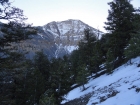
Early view of the impressive northwest face of North Twin. |
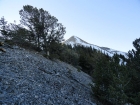
Heading up the north ridge of Red Cone Peak. |
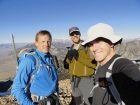
Red Cone Peak summit shot. |
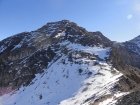
Good view of the west ridge of North Twin. |
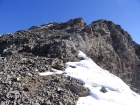
Typical terrain on the west ridge of North Twin. |

Looking across at South Twin. |
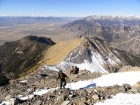
Michael climbing the west ridge of North Twin, Red Cone Peak in the background. |
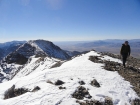
North Twin summit, with South Twin in the background. |

Descending the northeast ridge of North Twin. |
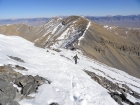
On our way northeast toward Productid Peak. |
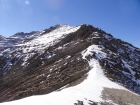
The impressive east face of North Twin, from the northeast ridge saddle. |
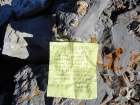
We found this note from Rick B in a film canister on the summit of Productid Peak (Peak 10677'). |
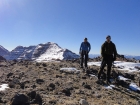
Leaving the summit of Productid Peak, North Twin in the background. |
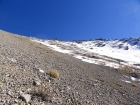
Scree and talus descent into upper Elbow Canyon. |
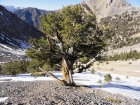
Impressive White Bark Pine we saw on the way down, a few hundred years old. |
|

















